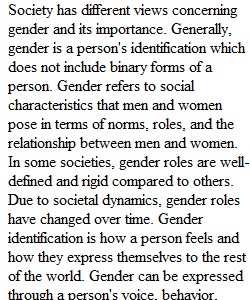


Q Grading Rubric- Gender Utopia Paper: SOC 205 Substantive content in the paper (60 points): 1. The paper contains a clear introduction to your utopian vision in the first paragraph (5 points). 2. The paper adequately addresses each of the four numbered components on the instruction prompt in paragraph form (40 points) 3. The paper contains at least four course concepts. The course concepts are well-incorporated into paper. (10 points). 4. The concluding paragraph provides a meaningful takeaway and demonstrates thoughtfulness and care (5 points) Organization, technical specifications, and writing: (40 points) 1. Organization: overall & within sections. Paper is well organized and has clear transition sentences and paragraphs are arranged appropriately and in a manner that is easy to follow (10 points) 2. Paper follows the technical specifications outlined in the prompt (including word count, formatting, page numbers) (10 points) 3. Paper includes appropriately cited in-text citations and an appropriately cited reference list (10 points) 4. The overall paper is well written. Word choices are intentional and careful. The paper contains minimal grammatical errors (10 points) ______________100 Total possible points Gender Concepts and Mainstream
View Related Questions